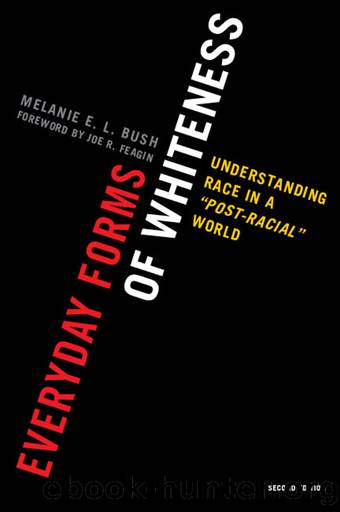Everyday Forms of Whiteness by Bush Melanie E. L.; Feagin Joe R.;

Author:Bush, Melanie E. L.; Feagin, Joe R.; [Bush, Melanie E. L.]
Language: eng
Format: epub
ISBN: 781774
Publisher: Rowman & Littlefield Publishers
The opportunity was provided ⦠now I have friends from Poland, I have Jewish friends, friends from basically everywhere and if the opportunity wasnât provided in college ⦠chances are at work I would never have met them. This was about the only opportunity that I had and now I have a few friends from basically other races, so the opportunity arose. (Joan, white female)
Itâs important to be somewhat worldly and have some knowledge of other races and cultures so you just donât sound stupid in a normal conversation. But it is important to feel comfortable and be able to help other people [from] different backgrounds. [Yet] I also donât think you need to run around with a checklist to make sure that I have a Columbian friend. (Jeff, white male)
In these passages, students articulate their beliefs that interaction between groups is positive and that they have benefited from experiences in which they have gotten to know people from different backgrounds. Another key finding in national research on diversity initiatives has been that virtually all students desired opportunities for interaction because they recognized that it prepares them for the world they live in. Additionally, as mentioned in chapter 2, exposure to diversity positively impacts academic success, cognitive development, and overall institutional satisfaction (Smith et al. 1997, vi). This seems to be recognized now in the corporate world, too, where increased diversity and multiculturalism are embraced because they are âgood for business.â Furthermore, the presence of racial diversity increases studentsâ capacity for integrative complexity, a cognitive outcome (Antonio et al. 2004, 509).
This section explored reasons given for the relatively minimal intergroup interaction among students outside campus that included parental and neighborhood pressures, and both implicit and explicit stigmas. Participants spoke about the effect that stereotypes have and their belief that people develop closer relationships with those who share similar backgrounds, live in close proximity, and therefore perceive to be better able to understand each other. Such beliefs directly relate to mechanisms that reinforce racialized patterns such as the segregation of everyday living, unwritten rules of interaction, and the social pressures supporting both individualism and competition. Openings exist in the recognition of the benefits of diversity, as well as in idealism and experiences that provide a vision of a more equal and just world. The ability of students to identify times in their lives when there was more interaction and shared experience provides an opportunity to construct those spaces through social and structural changes that serve the common good.
Several people express irritation that their usual pattern of interaction is being questioned and feel that to discuss this is intrusive. Others feel that the cycle of segregation is reproduced through lack of contact, knowledge, and experience. They raise the practical issue of how to become acquainted with people from other groups. Finally, participants noted numerous unwritten rules that undergird interaction. They feel that children learn the boundaries and consequences of stepping out of line. Kevin (white male staff) illustrates the seriousness with which
Download
This site does not store any files on its server. We only index and link to content provided by other sites. Please contact the content providers to delete copyright contents if any and email us, we'll remove relevant links or contents immediately.
| Anthropology | Archaeology |
| Philosophy | Politics & Government |
| Social Sciences | Sociology |
| Women's Studies |
Cecilia; Or, Memoirs of an Heiress — Volume 1 by Fanny Burney(31321)
Cecilia; Or, Memoirs of an Heiress — Volume 3 by Fanny Burney(30927)
Cecilia; Or, Memoirs of an Heiress — Volume 2 by Fanny Burney(30884)
The Great Music City by Andrea Baker(21166)
We're Going to Need More Wine by Gabrielle Union(18064)
Bombshells: Glamour Girls of a Lifetime by Sullivan Steve(13099)
Pimp by Iceberg Slim(12922)
All the Missing Girls by Megan Miranda(12739)
Fifty Shades Freed by E L James(12443)
Norse Mythology by Gaiman Neil(11873)
Talking to Strangers by Malcolm Gladwell(11858)
Crazy Rich Asians by Kevin Kwan(8340)
Mindhunter: Inside the FBI's Elite Serial Crime Unit by John E. Douglas & Mark Olshaker(7827)
The Lost Art of Listening by Michael P. Nichols(6460)
Enlightenment Now: The Case for Reason, Science, Humanism, and Progress by Steven Pinker(6402)
Bad Blood by John Carreyrou(5760)
The Four Agreements by Don Miguel Ruiz(5502)
Weapons of Math Destruction by Cathy O'Neil(5027)
We Need to Talk by Celeste Headlee(4861)
